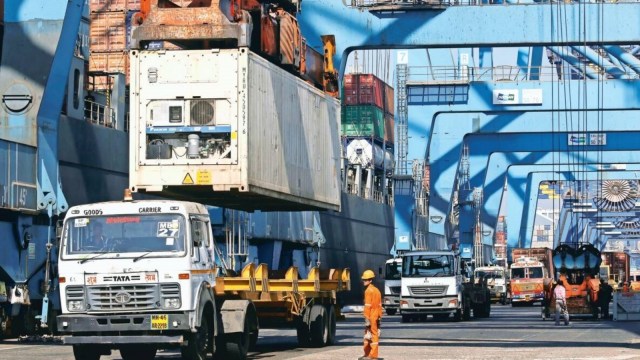
Over the past few years, global trade has been very volatile, first on account of the Covid-19 pandemic and then due to geopolitical conflicts. Since the middle of 2022, the value of global merchandise trade has shrunk continuously as per data from the United Nations Conference on Trade and Development. In fact, in 2023, global merchandise exports fell by 4.6 per cent. The January-March 2024 quarter, though, saw some sequential improvement.
India’s performance has been largely in line, with merchandise exports falling 4.7 per cent in 2023. This, however, was better than developing Asia as a whole, which saw merchandise exports decline by 6.8 per cent. In 2023-24, India’s merchandise exports stood at $437.1 billion, down 3.1 per cent from 2022-23. But the monthly data does suggest a pick up — after a 8.9 per cent contraction in the first half of the year, exports grew by 2.8 per cent in the second half. In the last quarter of the 2023-24 — a period when the threat of Red Sea disruptions on exports was partly playing out — exports grew at a faster pace of 4.5 per cent.
Besides an uncertain global environment, India has also had to deal with lower international commodity prices, which have reduced its export bill measured in dollars. Most international commodity prices (both energy and non-energy) have been declining after spiking due to the geopolitical conflict in Europe post February 2022.
In 2023-24, the sharp decline in crude oil prices was a big contributor to the fall in India’s overall merchandise export bill. India’s petroleum export bill was $13.3 billion lower, as crude oil prices fell $13 per barrel. With more than a 20 per cent share, oil is India’s single largest export item and hence, its movement has a large bearing on total merchandise export earnings. In volume terms, though, India exported more petroleum products last year.
Excluding petroleum and gems and jewellery exports (the other top export item which was also down 13.8 per cent last year), core exports were up 1.4 per cent, despite the broad-based decline in international commodity prices. This indicates that India was able to ship a higher volume of goods. According to quick estimates of the Ministry of Commerce and Industry, items with as much as 45 per cent share (in dollar terms) in India’s merchandise exports managed to grow last year.
The impressive 24 per cent growth in electronics goods exports last year reflects surging exports of telecom instruments or mobile handsets, spurred by the Production Linked Incentive scheme. The heft of electronics exports is visible from the fact that barring these, core exports registered a marginal decline last year. The share of electronic goods in the country’s merchandise exports has risen significantly — from around 2 per cent in 2017-18 to 6.5 per cent in 2023-24. While India continues to have a deficit in electronics goods trade, the ratio of value of electronic exports to imports has improved from 0.11 to 0.34, largely led by a surge in the share of telecom instruments.
Other large core categories such as drugs and pharmaceuticals, engineering goods and agricultural goods also saw healthy export growth. It is also noteworthy that despite the ban on non-basmati rice and wheat and some other curbs from time to time, overall agriculture and allied exports growth, led by other categories such as meat and poultry products, spices, fruits and vegetables, oil meals, oil seeds and unmanufactured tobacco remained healthy.
In terms of the country of destination, oddly, goods exports to the US — India’s largest market with solid economic growth in 2023 — contracted in 2023-24 as its growth was largely led by the services sector. However, there has been an uptick over the past few months. On the other hand, exports to the Euro region grew last year despite a sharp economic slowdown in the region, which has also been vulnerable to geopolitical uncertainties. While exports were largely led by petroleum products, other key items such as machinery, pharmaceutical products and auto and auto parts also rose.
India’s exports to the Gulf Cooperation Council (GCC) countries also rose, reflecting a further increase in exports to the UAE — the largest export destination of Indian goods in the GCC region. It is noteworthy that India’s gems and jewellery exports to UAE increased by a whopping 42.3 per cent during April-February 2023-24 even as India’s overall gems and jewellery exports declined by 14.5 per cent during this period.
However, it is a matter of concern that exports of labour-intensive sectors such as gems and jewellery, textile products (largely ready-made garments), leather and leather products, marine products and plastics, declined last year. In fact, the share of most of the labour-intensive categories in the country’s merchandise exports has come down drastically over the last decade. For instance, the share of gems and jewellery exports in India’s merchandise exports fell from 13.2 per cent in 2014-15 to 7.5 per cent in 2023-24. Similarly, the share of textile exports is down from 11.1 per cent to 7.5 per cent. Arresting this decline must be a priority.
That said, over the past few quarters, goods exports have fared well. What also bodes well for India’s exports is the upward revision to global growth and trade projections by multilateral agencies. S&P Global expects global growth at a healthy 3.2 per cent in 2024 compared to 2.8 per cent earlier. WTO projects world trade volume to grow 2.6 per cent in 2024 from -1.2 per cent in 2023. Bilateral free-trade agreements with major economies and the ongoing push to manufacturing should also spur India’s exports in the near to medium term. In the base-case scenario, exports should grow at a healthy rate and contribute to the overall growth momentum. The spoilers would be uneven global growth and geopolitical tensions which will bear watching.
Joshi is chief economist, Verma is senior economist, and Meera Mohan is economic analyst, CRISIL Ltd


